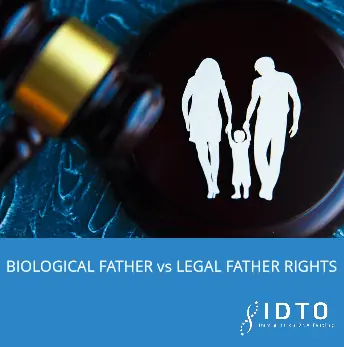What’s the Difference Between a Legal Father and Biological Father?
While people typically assume the legal father and biological father are one and the same, important distinctions in roles and responsibilities exist.
Biological Father
- Contributes DNA/genetic material leading to conception.
- Obligation to provide financial support.
- Option to seek custody/visitation rights through court.
Legal Father
- Parent-child relationship recognized legally and socially.
- Named on birth certificate and conferring citizenship rights.
- Has responsibility for health, education and welfare decisions.
- Responsible for physical and financial childcare support.
- Full custody and guardianship rights – addressing medical care, schooling choice, domicile location, access to activities, legal authorization for procedures, etc.
Biological Father vs. Legal Father – A Comparison of Rights
While biological fathers have specific rights conferred by genetic ties, legal fatherhood grants additional privileges and standing:
Biological Fathers’ Rights
- Seek custody or visitation rights for minor child through the courts
- Require consent for adoption in some jurisdictions
- Challenge paternity of another man named the legal father
- Submit affidavit voluntarily establishing paternity
Legal Fathers’ Rights
- Presumption of fatherhood for children born into intact marriages
- Named on birth certificate and conferring citizenship
- Granted physical and legal custody automatically
- Full parental decision authority over medical care, education, domicile
- Access to medical/school records
- Ability to permit medical treatments and procedures
- Travel approval rights within certain countries
We recommend that you speak with a legal professional in your state regarding paternity and family law guidelines
Emotional Aspects and Interpersonal Dynamics
The legal versus biological father distinction influences and complicates family relationships and personal connections.
Scenarios exist where a devoted legal father raises a child not biologically his own unknowingly. If mismatched paternity is revealed, intense emotions can result from feeling bonded to a child that doesn’t share your DNA.
For children, having two father figures vying equally for their love and affection instead of a clear paternal relationship can cause internal conflict and confusion growing up.
Biological fathers who lacked early presence or support opportunities due to unawareness of their genetic tie may mourn lost moments and have strained bonds requiring time to strengthen.
Co-parenting challenges manifest too when the legal father and biological father differ, like navigating childcare schedules or financial obligations. Open communication helps mitigate interpersonal challenges.
In optimizing outcomes for children, experts emphasize prioritizing emotional nurturing and stability while determining legal rights and responsibilities. Individual counseling can assist all parties in processing complex feelings surrounding divided or uncertain paternal roles.
Related Topics
Alleged Father vs Presumed Father
Beyond biological and legal fathers, classifications exist like alleged father and presumed father.
Alleged Father
- Man claimed to be biological father without confirmation
- No legal rights or paternal presumption applied
Presumed Father
- Status applies in select scenarios prior to biological proof
- Marital presumption: Husband in intact marriage presumed father
- Public acknowledgement of paternity may confer presumption
The law allows for temporary fatherhood rights/duties if a presumption exists until disproven by DNA paternity testing. An alleged father by contrast has no standing without evidence he contributed genetic material.
Biological Fathers vs. Step-fathers
Step-fathers assume a fatherly role by marrying the child’s mother, but are not the biological or adoptive father.
Biological Father
- Biological and genetic tie
- Right to seek custody or visitation
- Financial child support obligations
Step-Father
- No biological relationship
- Benefits from living with step-child full-time
- Unlikely to have assigned child support duty
So while step-fathers can be actively involved day-to-day, they do not take over the biological father’s legal rights or formal responsibilities. Defining roles prevents confusion if the marriage ends.
How are DNA tests used to help determine paternity?
DNA paternity tests are used for the following:
- Proof of biological relationship for Child Support and child custody cases
- Proof of biological relationship for Birth Certificate (adding the father’s name to the birth certificate)
- Inheritance: Estate cases when an alleged father is deceased.
- Immigration: Petitioning for a biological child
- Proof of biological relationship to provide evidence to a judge to gain legal rights for your child.
Accuracy of DNA test results
The accuracy of legal DNA paternity test results on average for each must have probability of paternity of 99.99% percent or higher for any legal purpose.
To learn more about Paternity Testing use as it pertains to your situation please contact one of our DNA Testing Experts today at 877-680-5800 or visit our paternity testing page here to learn more.

